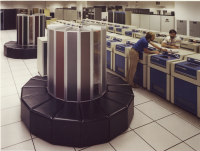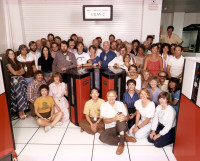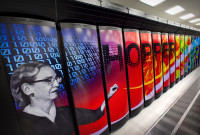40 Years of NERSC Firsts
A look back at some of NERSC's many milestones
January 29, 2014
From its humble beginnings in 1974, NERSC has grown and expanded in terms of both supercomputing capabilities and user services. Here we present some highlights:
1974: In July, local researchers begin running jobs at the Controlled Thermonuclear Research (CTR) Computer Center at LLNL on a borrowed Control Data Corp. 6600 computer (serial no. 1), giving them access to a machine once reserved for defense-related research.

The Cray-1 sold for about $8 million in 1978 (around $38 million in 2023.)
1975: A new CDC 7600 computer is installed at the center in September, and connectivity is provided by the 16 dial-up ports on the 6600.
1976: The CTR Computer Center is renamed the National Magnetic Fusion Energy Computer Center.
1978: In May, the NMFECC received a new Cray-1 with a peak speed of 138 mflops. NMFECC undertakes a major software project to convert the 7600 operating system (LTSS or Livermore Time Sharing System), utilities, and libraries to the new Cray-1.
1984: To accommodate NERSC’s growing user base, which now numbers 3,500, a Cray X-MP is added to the NMFECC. The arrival of the new machine and the addition of 500 new users produces a heavy workload for the consultants, rocketing the number of contacts from 25 to more than 100 per day.
1985: The center acquires the first Cray-2 supercomputer, the most powerful computer in the world at the time. The four-processor machine, along with the two-processor X-MP, allows multiprocessing of codes, which greatly accelerates the speed of computing.

The world's first Cray-2 was installed at NERSC in 1985.
1987: The broadening role of NMFECC in supporting DOE programs finds nearly a third of the computing resources going to projects other than fusion research. Basic Energy Sciences accounts for nearly 15 percent of the total allocations, health and environment 14 percent, high energy and nuclear physics 12 percent, and applied math 2.5 percent.
1990: The center is renamed the National Energy Research Supercomputer Center to reflect its broadened mission.
1993: In June, the Top 500 list of supercomputer sites around the world debuts. NERSC’s Cray C-90 places number 24 on the list.
1995: In April, DOE asked Lawrence Livermore National Laboratory and Lawrence Berkeley National Laboratory to submit proposals on the future operation of NERSC. In November, DOE announced its decision to relocate NERSC to Berkeley Lab.
1999: NERSC installs an IBM RS/6000 SP supercomputer as its flagship system and names it “Seaborg” in honor of Berkeley Lab Nobel Laureate Glenn Seaborg. At its peak, it performed about 10 trillion calculations per second (10 teraflop/s).

The "Franklin" Cray XT4 was the first NERSC computer to make the top 10 in the Top 500 list.
2000: In November, NERSC's computing and storage systems moved from Berkeley Lab's main site to the Oakland Scientific Facility in downtown Oakland.

"Hopper," a Cray XE6 installed at NERSC in 2010 and still in use today, honors computing pioneer Grace Hopper.
2007: In 2007, NERSC's Franklin Cray XT4 computer was ranked 9th in the world on the Top 500 list, the first time a NERSC computer made the top 10.
2010: NERSC’s first petaflop system, a Cray XE6 named “Hopper” in honor of computing pioneer Grace Hopper, places number 5 on the November 2010 Top500 Supercomputer list.
2013: NERSC installs its fastest supercomputer yet: “Edison,” a Cray XC30 named in honor of Thomas Alva Edison.
About NERSC and Berkeley Lab
The National Energy Research Scientific Computing Center (NERSC) is a U.S. Department of Energy Office of Science User Facility that serves as the primary high performance computing center for scientific research sponsored by the Office of Science. Located at Lawrence Berkeley National Laboratory, NERSC serves almost 10,000 scientists at national laboratories and universities researching a wide range of problems in climate, fusion energy, materials science, physics, chemistry, computational biology, and other disciplines. Berkeley Lab is a DOE national laboratory located in Berkeley, California. It conducts unclassified scientific research and is managed by the University of California for the U.S. Department of Energy. »Learn more about computing sciences at Berkeley Lab.







